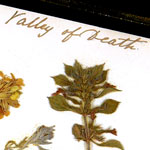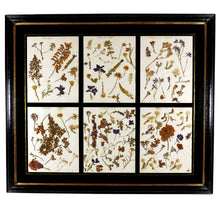Victorian Pressed Flowers From the Crimean Battlefields, 1856
Adding product to your cart
Overall: 60cm (24in) x 69cm (27.5in)
Six pages of specimens collected and pressed by Lieutenant Owen Tudor Burne, 20th East Devon Regiment. Nineteen year-old Burne arrived in the Crimea in charge of a draft of 200 recruits four days after the cessation of hostilities with Imperial Russia on 30 March 1856. He was one of the first visitors to the battlefields made familiar to the Victorian public through the reportage of William Howard Russell of The Times and pioneer photographer Roger Fenton. Each sheet titled in Burne’s hand - viz. ‘Sebastopol’; ‘Valley of Death’; Tchergoum & Mangoup Kali’; ‘Inkerman’; ‘Balaklava’; and ‘Different Parts’. Contained under glass with reverse painted border in an ebonized and gilt frame.
Read more
Major-General Sir Owen Tudor Burne, G.C.I.E., K.S.I.,(1837–1909) was the eleventh of nineteen children of the Rev. Henry Thomas Burne (1799-1865). He received a commission in the XXth Regiment in 1855, and spent four months in the Crimea. After a year at Aldershot, he was ordered to India with his regiment to take part in the suppression of the Great Mutiny of 1857-58. On the voyage out he studied Hindustani and after landing was appointed a brigade-major in the 4th Infantry Division. He took part in in fifteen actions against the rebels, including the capture of Lucknow. On 14 March, when Franks's division attacked the Kaisar Bagh and Imambara, he was brigade-major of the column of attack, and was one of the first to get through the gate of the Kaisar Bagh. He was actively engaged until Lucknow fell on 21 March, having been recommended for the Victoria Cross on 11 March 1858 albeit without result. He nevertheless received a double promotion for gallantry in the field.
Burne was subsequently appointed Military Secretary to Commander-in-Chief of India. In 1865 he continued with his chief to Ireland. Two years later Burne received the thanks of government for his part in exposing the Fenian conspiracy. At the end of 1868 Burne returned to India as private secretary to the Viceroy, Lord Mayo, and was with Mayo in the Andaman Islands the he was assassinated. Burne continued as private secretary to Lord Napier and Ettrick who temporarily assumed the office of Viceroy. Burne later reported in person to Queen Victoria at Osborne the details of Lord Mayo's death, and was created C.S.I.
He was next appointed political aide-de-camp to the Secretary of State for India and oversaw arrangements for all native embassies and chiefs visiting England, and to assist the India office generally on native questions. In April 1874 he became secretary and Head of the Political and Secret Department. In that capacity he was in continual personal consultation with the Lord Salisbury, Secretary of State, on the Central Asian and the Afghanistan questions.
In 1876 Burne arrived once more in India as private secretary for a two years' term to the new viceroy, Lord Lytton. To Burne was largely due the success of the ceremonial proclamation at Delhi of Queen Victoria as Empress of India. In 1880 he ably negotiated with the Nawab Nazim of Bengal a settlement highly satisfactory to the Indian exchequer, and the affairs of Maharaja Duleep Singh were placed under his supervision. In December 1886 he joined the Council of India, filling the Vice-Presidency in 1895 and 1896, and retiring on 31 Dec. 1896, when he was made G.C.I.E. He had been promoted Major-General in 1889.
Burne had literary aptitude, and from 1879 was a regular contributor to ‘The Times’ on Eastern questions and an occasional contributor to magazines. He wrote ‘Clyde and Strathnairn’ for the Oxford series of ‘Rulers of India’ in 1891; and an autobiography entitled ‘Memories’ (1907). He was a royal commissioner for numerous international exhibitions, and was member of the international congress of hygiene and demography (1894). After his retirement from the India office he busily engaged in philanthropic, mercantile, and other public work.






